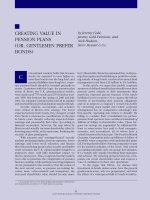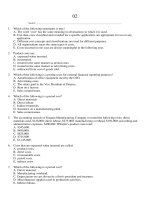Lecture Managerial accounting: Creating value in a dynamic business environment (10th edition): Chapter 6 - Ronald W. Hilton, David E. Platt
Bạn đang xem bản rút gọn của tài liệu. Xem và tải ngay bản đầy đủ của tài liệu tại đây (598.99 KB, 33 trang )
Chapter 6
Activity Analysis,
Cost Behavior, and
Cost
Estimation
Copyright © 2014 McGraw-Hill Education. All rights reserved. No reproduction or distribution without the prior written consent of McGraw-Hill Education.
Introduction
Cost
estimation
Cost
behavior
Cost
prediction
Process of
determining
cost behavior,
often focuses
on historical
data.
Relationship
between
cost and
activity.
Using knowledge
of cost behavior
to forecast
level of cost at
a particular
activity. Focus
is on the future.
62
Total Variable Cost Example
Total Pay Per View Bill
Y our total Pay Per View bill is based on how many Pay
Per View shows that you watch.
Number of Pay Per View shows
watched
63
Variable Cost Per Unit Example
Cost per Pay Per View
show
The cost per Pay Per View show is constant. For example,
$4.95 per show.
Number of Pay Per View
shows watched
64
Step-Variable Costs
Cost
Total cost remains
constant within a
narrow range of
activity.
Activity
65
Step-Variable Costs
Cost
Total cost increases to a
new higher cost for the
next higher range of
activity.
Activity
66
Total Fixed Cost Example
Monthly Basic
Cable Bill
Y our monthly basic cable TV bill probably does not change
no matter how many hours you watch.
Number of hours watched
67
Fixed Cost Per Unit Example
Monthly Basic cable Bill
per hour watched
The average cost per hour decreases as more hours are
spent watching cable television.
Number of hours watched
68
Step-Fixed Costs
Total cost doesn’t change for a wide range of
activity, and then jumps to a new higher cost for the
next higher range of activity.
Rent Cost in
Thousands of Dollars
90
60
30
0
1,000
2,000
3,000
Rented Area (Square Feet)
69
Semivariable Cost
A semivariable
cost is partly
fixed and partly
variable.
Consider the
following
example:.
610
Semivariable Cost
Total Lease Cost
The slope is
the variable
cost per unit
of activity.
iv
m
se
l
ta
o
T
l
b
a
ari
s
o
ec
t
Variable Lease
Charge Per Hour
Fixed Monthly
Rental Charge
Rental Charge Per Hour
611
Total Cost
Curvilinear Cost
Relevant Range
Curvilinear
Cost Function
A straight-line
(constant unit
variable cost) closely
approximates a
curvilinear line within
the relevant range.
Activity
612
Total Cost
Curvilinear Cost
Relevant Range
Curvilinear
Cost Function
A straight-Line
(constant unit
variable cost) closely
approximates a
curvilinear line within
the relevant range.
Activity
613
Engineered, Committed, and
Discretionary Costs
Committed
Discretionary
Long-term, cannot be
reduced in the short
term.
May be altered in the
short term by current
managerial decisions.
Engineered
Physical relationship
with activity measure.
Depreciation on
Buildings and
equipment
Direct
Materials
Advertising and
Research and
Development
614
Visual-Fit Method
A scatter diagram of past cost behavior
may be helpful in analyzing mixed costs.
615
Visual-Fit Method
Total Cost in
1,000’s of Dollars
Plot the data points on a
graph (total cost vs. activity).
20
10
0
* *
* *
* ** *
**
0
1
2
3
4
Activity, 1,000’s of Units Produced
616
Visual-Fit Method
Total Cost in
1,000’s of Dollars
Draw a line through the plotted data points so that about
equal numbers of points fall above and below the line.
20
10
0
* *
* *
* ** *
**
0
1
2
3
4
Activity, 1,000’s of Units Produced
617
Visual-Fit Method
Total Cost in
1,000’s of Dollars
Estimated fixed cost = $10,000
20
10
0
* *
* *
* ** *
Vertical distance
**
is total cost,
approximately
$16,000.
0
1
2
3
4
Activity, 1,000’s of Units Produced
618
The High-Low Method
Owl Co recorded the following production activity &
maintenance costs for two months:
High activity level
Low activity level
Units
9,000
5,000
Cost
$ 9,700
6,100
Using these two levels of activity, compute:
the variable cost per unit.
the total fixed cost.
619
The High-Low Method
High activity level
Low activity level
Change
Units
9,000
5,000
4,000
Cost
$ 9,700
6,100
$ 3,600
620
The High-Low Method
High activity level
Low activity level
Change
Unit variable cost =
Units
9,000
5,000
4,000
Cost
$ 9,700
6,100
$ 3,600
in cost
in units
621
The High-Low Method
High activity level
Low activity level
Change
Units
9,000
5,000
4,000
Cost
$ 9,700
6,100
$ 3,600
Unit variable cost = $3,600 ÷ 4,000 units = $0.90 per unit
622
The High-Low Method
High activity level
Low activity level
Change
Units
9,000
5,000
4,000
Cost
$ 9,700
6,100
$ 3,600
Unit variable cost = $3,600 ÷ 4,000 units = $0.90 per unit
Fixed cost = Total cost – Total variable cost
623
The High-Low Method
High activity level
Low activity level
Change
Units
9,000
5,000
4,000
Cost
$ 9,700
6,100
$ 3,600
Unit variable cost = $3,600 ÷ 4,000 units = $0.90 per unit
Fixed cost = Total cost – Total variable cost
Fixed cost = $9,700 – ($0.90 per unit × 9,000 units)
624
The High-Low Method
High activity level
Low activity level
Change
Units
9,000
5,000
4,000
Cost
$ 9,700
6,100
$ 3,600
Unit variable cost = $3,600 ÷ 4,000 units = $.90 per unit
Fixed cost = Total cost – Total variable cost
Fixed cost = $9,700 – ($.90 per unit × 9,000 units)
Fixed cost = $9,700 – $8,100 = $1,600
625









